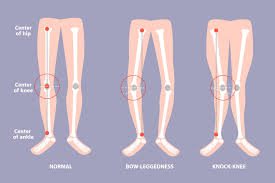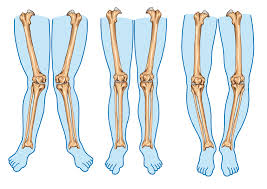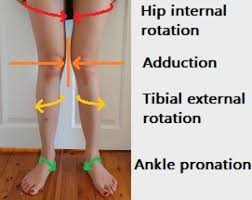

Forward Head Posture (FHP), often called “tech neck,” is one of the most widespread postural problems of the modern era—thanks to our screen-heavy routines.
While the strain it places on the neck and upper back is widely recognized, its ripple effects extend far beyond the shoulders. One lesser-known consequence is its impact on lower leg alignment. FHP shifts the body’s center of gravity forward, prompting a cascade of compensations down the kinetic chain.
To prevent a fall, the hips tilt, the knees lock, and the ankles stiffen—all to realign the body’s balance. This altered distribution of forces ultimately changes the mechanics of the lower legs, contributing to problems like overpronation, shin splints, or even chronic calf tightness.
Over time, these misalignments can lead to inefficient gait, reduced mobility, and increased risk of injury.
In this article, bestforwardheadposturefix research team shall uncover exactly how a forward-leaning head can throw off your foundation—one step at a time.
Article Index
- Understanding Forward Head Posture
- The Kinetic Chain: Connecting Head to Toes
- Impact on Pelvic Alignment
- Alterations in Knee Mechanics
- Changes in Ankle and Foot Positioning
- Proprioception and Balance Challenges
- Implications for Gait and Movement
- FAQs on Lower Leg Alignment and Text Neck
- Strategies for Correction and Prevention
Understanding Forward Head Posture
Forward Head Posture (FHP) is not just a quirky tilt of the chin—it is a full-blown postural rebellion.
Defined by the head jutting forward in front of the spine like it is trying to escape, FHP places excessive strain on the cervical vertebrae, much like carrying a bowling ball a few inches in front of your face all day.
But here is the twist: it doesn’t stop at the neck.
This seemingly small misalignment acts like a domino, triggering compensations all the way down the body. Your spine curves unnaturally, your hips shift, your knees hyperextend, and your ankles may even roll inward causing arch pain.
Ever seen someone standing with their knees locked and feet splayed outward? FHP might be the silent saboteur.
Think of your posture like a stack of building blocks—nudge the top one out of place, and the whole tower has to adjust to keep from toppling. FHP rewrites your body’s blueprint, and your legs end up rewriting theirs in response.
The Kinetic Chain: Connecting Head to Toes
The human body isn’t just a pile of parts—it is a tightly choreographed kinetic chain, where one wrong move sends ripples through the whole performance.
Forward Head Posture (FHP) throws off this dance by nudging the head forward, and suddenly, your center of gravity is playing a game of leapfrog. To keep you from face-planting, the rest of your body scrambles into damage control.
The spine arches, the pelvis tilts, knees hyperextend like they are auditioning for a mannequin pose, and ankles stiffen like they have seen a ghost. It is not elegance—it is emergency geometry. This isn’t just poor posture; it is a full-body reaction to keep you upright.
The irony? A problem that starts at the top ends up wreaking havoc all the way down to your toes.
So, next time you catch yourself craning toward your phone, remember: your neck’s rebellion could be rewriting the rules for your knees and ankles too.
Impact on Pelvic Alignment
Forward Head Posture (FHP) does not just mess with your neck—it sets off a chain reaction all the way to your feet.
One major consequence? Anterior pelvic tilt.
As your head juts forward, your body compensates by tilting the pelvis forward—imagine a bowl tipping forward and spilling its contents. This anterior tilt causes an exaggerated lumbar lordosis, or an overarched lower back, which in turn shifts the alignment of the hips and thighs.
When the pelvis tips, the femurs (thigh bones) often rotate internally, changing the angle at which your knees track and how your feet strike the ground.
This cascade disrupts the normal distribution of forces through the lower limbs. The knees may begin to collapse inward (valgus), and the ankles often follow suit, leading to issues like overpronation, shin splints, or Achilles tendon stress.
So yes—what starts in your neck can quietly hijack your lower body’s mechanics, one pelvic tilt at a time.
Alterations in Knee Mechanics
When Forward Head Posture (FHP) causes the pelvis to tilt forward—aka anterior pelvic tilt—it sets off a biomechanical domino effect. As the pelvis tips, the femurs (thigh bones) tend to rotate inward.
This internal rotation can lead to a condition known as knock-knees, or genu valgum, where the knees angle inwards and touch while the ankles remain apart. Think of it like the knees trying to high-five each other mid-stride.
This altered alignment places uneven stress on the medial (inner) side of the knee joint, which is not built to bear the bulk of your body weight alone. Over time, this can cause pain, joint wear, and an increased risk of injuries like patellar tracking issues or ACL strain.
Athletes, especially runners and dancers, often experience this kind of misalignment and the problems it brings.
Since proper knee alignment is key for shock absorption and energy efficiency, keeping your head and pelvis in check is more than just a posture perk—it’s a joint-saving strategy.
Changes in Ankle and Foot Positioning
Forward Head Posture (FHP) might start at the neck, but its ripple effect travels all the way to your toes—literally. When the head shifts forward, the body’s center of gravity also moves forward, forcing your lower body to adapt in order to keep you upright.
One major adaptation happens at the feet: overpronation. This is when the foot rolls inward more than it should during walking or running.
While a little pronation is normal and necessary for shock absorption, excessive inward rolling can spell trouble.
Overpronation alters the mechanics of the lower legs, creating uneven pressure through the arch, heel, and ankle. As a result, muscles and tendons in the foot and shin—like the plantar fascia and tibialis anterior—endure more strain than they were designed for.
The result?
A greater risk of painful conditions such as plantar fasciitis, Achilles tendonitis, or the dreaded shin splints. Bottom line: a forward head can flatten your stride, literally and biomechanically.
Proprioception and Balance Challenges
Forward Head Posture (FHP) does more than strain muscles—it messes with your internal GPS. Proprioception, your body’s ability to sense its position in space, relies heavily on accurate input from joints and muscles. But with FHP, that input gets scrambled.
Studies have shown that people with FHP exhibit decreased joint position sense not just in the cervical spine but also in the ankles—a double whammy for balance. Imagine walking on a balance beam while wearing a crooked helmet and loose shoes.
That is essentially what your brain experiences when trying to coordinate movement with FHP in play. Poor proprioception can cause clumsy foot placement, delayed reaction times, and wobbly stability during dynamic tasks like running, jumping, or even changing directions quickly.
For athletes, this means a greater chance of sprains or falls; for older adults, a heightened risk of trips and fractures. In short, forward head = confused feet—and that’s not a combo anyone wants.
Implications for Gait and Movement
The ripple effects of Forward Head Posture (FHP) don’t stop at the neck—they eventually alter how you walk. With the head jutting forward, your body constantly compensates to stay balanced, and this includes changes in gait.
One of the first noticeable shifts is a reduction in stride length; each step becomes shorter and more cautious. Walking speed also tends to decrease, not out of laziness, but because the body is subtly working harder to stabilize itself.
Add in asymmetrical movement—where one side of the body compensates more than the other—and you’ve got a recipe for imbalance. This inefficient gait increases strain on muscles and joints that were not built to carry that kind of workload.
Over time, this can lead to overuse injuries like iliotibial band syndrome, patellar tendinitis, or even hip bursitis. So if your walk feels more like a shuffle or lopsided waddle, FHP may be the silent saboteur throwing off your stride.
Strategies for Correction and Prevention
Addressing FHP and its impact on lower leg alignment involves a multifaceted approach:
- Postural Awareness: Regularly check and correct head and neck positioning during daily activities.
- Strengthening Exercises: Focus on strengthening the deep cervical flexors, core muscles, and hip stabilizers to support proper alignment.
- Stretching: Incorporate stretches for the chest, hip flexors, and calves to alleviate tightness contributing to misalignment.
- Footwear: Choose supportive shoes that promote proper foot alignment and consider foot orthotics if necessary.
- Professional Guidance: Consult with physical therapists or chiropractors for personalized assessment and intervention strategies.
FAQs on Lower Leg Alignment and Text Neck
Q-1: How can a forward head posture (FHP) change where forces land on my lower legs and feet?
A-1: When the head drifts forward, your center of mass shifts anteriorly. That subtle lean increases forefoot loading and postural sway. The ankle–foot complex often compensates by pronating a bit more to widen the base of support. Over time, that “catch me up front” strategy can bias tibial rotation and calf/soleus workload, especially if you spend hours looking down at phones or laptops.
Q-2: Can neck alignment really influence knee tracking or tibial rotation during daily standing and walking?
A-2: Indirectly, yes. Forward head changes how ground reaction forces pass through the foot. More pronation at the foot commonly couples with internal rotation of the tibia, which can nudge the knee toward a mild valgus (inward) tendency. It’s a kinetic-chain ripple: head position alters trunk balance, which shifts foot mechanics, which then influences how the shin and knee align under load.
Q-3: Is this only a standing issue, or does FHP also alter gait?
A-3: Gait can be affected. With the head forward, your balance system works harder to manage momentum, often shortening step length and encouraging a slightly flatter foot strike. People may feel quicker calf fatigue, tighter shins, or “grippy” toes on longer walks. Improving head–torso stacking frequently restores a smoother roll from heel to toe and reduces that front-of-foot cling.
Q-4: If I improve my cervical posture, can foot-loading patterns change right away?
A-4: Often, yes. Try a quick A/B: stand barefoot, notice where pressure sits (heel vs. mid/forefoot). Then add a gentle chin nod, lengthen the back of your neck, and lift the sternum without flaring the ribs. Many notice pressure ease backward toward the heels within seconds, with less midfoot “splat.” That immediate shift hints that better head alignment reduces the need for the foot to over-pronate to keep you steady.
Q-5: What practical steps align the neck and protect the lower legs during desk-heavy days?
A-5: Pair upstream resets with downstream strength:
Upstream: raise screens to eye level; every 60 minutes, stand, exhale slowly twice, add 5–8 gentle chin-nod reps, and re-stack head over sternum.
Downstream: build foot intrinsics (short-foot drills, toe spreads), train calf/soleus endurance (slow, full-range raises), and use supportive shoes or temporary orthoses for long standing bouts.
Integration: practice a 10–20 step “carryover walk” after each reset—eyes level, sternum lifted, quiet chin nod—then resume work. Track a weekly side photo (ear closer over shoulder) and a quick pressure check (more heel, less midfoot).
This two-ended approach calms the forward drift that provokes pronation while giving the lower leg the strength and alignment it needs to share the load.
Conclusion
Forward Head Posture (FHP) is more than just a neck issue—it is a chain reaction that travels down the spine, distorting lower leg alignment and disrupting full-body posture.
As the head shifts forward, the body makes structural compromises, from pelvic tilt to knee rotation and foot overpronation. These changes not only affect appearance but also impact balance, coordination, and joint health. Recognizing this domino effect is crucial for anyone aiming to improve posture or prevent injury.
With corrective exercises, ergonomic adjustments, and postural awareness, it is possible to reverse these effects—restoring harmony in movement and supporting long-term musculoskeletal health.
References:

